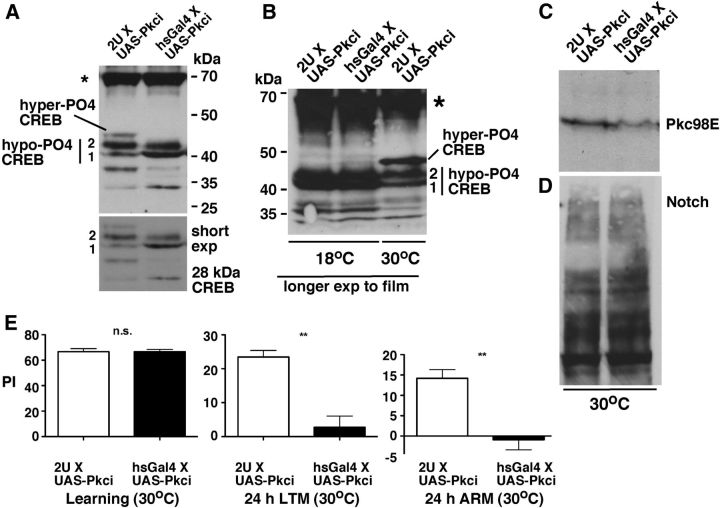Figure 7.
Suppression of Pkc98E expression suppresses hyper-PO4 CREB accumulation and LTM formation. A, RNAi-mediated knockdown of Pkc98E expression in adult flies suppresses accumulation of hyper-PO4 CREB. A UAS-Pkci transgene was expressed using the heat shock promoter-driven Gal4 (hsGal4XUAS-Pkci). 2U is a WT strain into which the hsGal4 strain was backcrossed for six generations and therefore served as the control (2UXUAS-Pkci). Shorter exposure of the blot to film (bottom image) shows that the level of hypo-PO4 CREB 2 is reduced and the level of hypo-PO4 CREB 1 is increased in hsGal4XUAS-Pkci flies, indicating that hypo-PO4 CREB1 is the substrate for hypo-PO4 CREB2 and hyper-PO4 CREB. B, Hyper-PO4 CREB is expressed at comparable levels in 2UXUAS-Pkci and hsGal4XUAS-Pkci flies reared at 18°C (the first two lanes). Lane 3 shows 2UXUAS-Pkci flies reared at 30°C to mark the position of hyper-PO4 CREB. Although the level of this CREB isoform is expressed at low levels at 18°C, the levels are about the same in the two genotypes. C, Pkc98E expression is reduced in hsGal4XUAS-Pkci flies relative to the level in the control 2UXUAS-Pkci flies (as expected). D, Notch protein levels are not significantly different between hsGal4XUAS-Pkci and the control 2UXUAS-Pkci flies. E, Loss of Pkc98E does not affect learning but severely reduces both LTM and ARM. While learning was tested immediately after single training, LTM and ARM were measured 24 h after multiple trainings. Data are mean ± SEM; N = 4 for each genotype. **p < 0.01 (Student's t test). n.s., Not significant. Flies were reared at 18°C until adult emergence (under light-dark cycle), and the newly emerged adults were aged for 5 d at 18°C or 30°C (under light-dark cycle) before use. A, B, *Background band that serves as an additional loading control. The same fly equivalents were loaded in each lane of blots in A–D.

